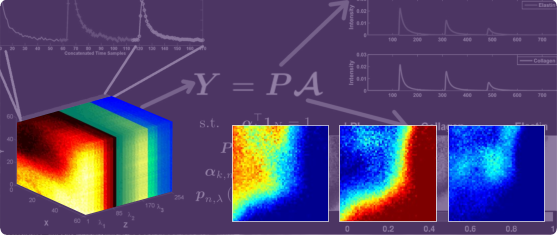O. Gutierrez-Navarro, D. U. Campos-Delgado, E. R. Arce-Santana, M. O. Mendez, and J. A. Jo

This paper proposes a new blind end-member and abundance extraction (BEAE) method for multi-spectral Fluorescence Lifetime Imaging Microscopy (m-FLIM) data. The proposed method is based on a linear mixture model with joint positivity and sum-to-one restrictions on the abundances and end-members to compensate for signatures variability. The proposed method was validated by using synthetic m-FLIM datasets at different signal-to-noise ratios (SNR), and it was also validated with six m-FLIM datasets from fresh post-mortem human coronary atherosclerotic plaques. A comparative evaluation of the BEAE was made against two popular techniques: Minimum Volume Constrained Non-negative Matrix Factorization (MVC-NMF), and Multivariate Curve Resolution – Alternate Least Squares (MCR-ALS). It was shown that the proposed method (BEAE) can provide more accurate estimates of the end-members despite different initial conditions in the iterative optimization procedure and noise effects, and it is faster than the MVC-ALS.
Tags: Blind source separation, autofluorescence, endmember extraction, fluorescence imaging, linear spectral unmixing, quadratic optimization

